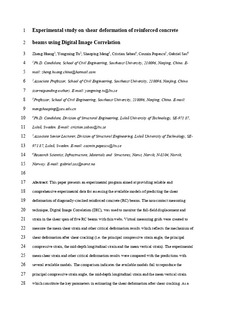| dc.contributor.author | Huang, Zheng | |
| dc.contributor.author | Tu, Yongming | |
| dc.contributor.author | Meng, Shaoping | |
| dc.contributor.author | Sabau, Cristian | |
| dc.contributor.author | Popescu, Cosmin | |
| dc.contributor.author | Sas, Gabriel | |
| dc.date.accessioned | 2020-02-07T10:08:01Z | |
| dc.date.available | 2020-02-07T10:08:01Z | |
| dc.date.created | 2019-05-30T14:33:05Z | |
| dc.date.issued | 2019 | |
| dc.identifier.citation | Engineering structures. 2019, 181 670-698. | nb_NO |
| dc.identifier.issn | 0141-0296 | |
| dc.identifier.uri | http://hdl.handle.net/11250/2640282 | |
| dc.description.abstract | This paper presents an experimental program aimed at providing reliable and comprehensive experimental data for assessing the available models of predicting the shear deformation of diagonally-cracked reinforced concrete (RC) beams. The non-contact measuring technique, Digital Image Correlation (DIC), was used to monitor the full-field displacement and strain in the shear span of five RC beams with thin webs. Virtual measuring grids were created to measure the mean shear strain and other critical deformation results which reflects the mechanism of shear deformation after shear cracking (i.e. the principal compressive strain angle, the principal compressive strain, the mid-depth longitudinal strain and the mean vertical strain). The experimental mean shear strain and other critical deformation results were compared with the predictions with several available models. The comparison indicates the available models fail to reproduce the principal compressive strain angle,the mid-depth longitudinal strain and the mean vertical strain which constitute the key parameters in estimating the shear deformation after shear cracking. As a result, significant discrepancies in the shear deformation of the beams tested in this paper are observed between the experimental and calculated results. It is also found that the predicted shear deformation of a number of beam specimens tested by other researchers with the available models deviates considerably from the experimental results. In general, the existing models are not capable of providing accurate predictions of the shear deformation of RC beams and further investigation into this topic is needed. | |
| dc.language.iso | eng | nb_NO |
| dc.relation.uri | https://www.sciencedirect.com/science/article/pii/S0141029618317917 | |
| dc.subject | Experimental study | |
| dc.subject | Shear deformation | |
| dc.subject | Reinforced concrete beams | |
| dc.title | Experimental study on shear deformation of reinforced concrete beams using digital image correlation | nb_NO |
| dc.type | Journal article | nb_NO |
| dc.type | Peer reviewed | nb_NO |
| dc.description.version | submittedVersion | |
| dc.subject.nsi | VDP::Bygningsmaterialer: 525 | |
| dc.subject.nsi | VDP::Building materials: 525 | |
| dc.source.pagenumber | 670-698 | nb_NO |
| dc.source.volume | 181 | nb_NO |
| dc.source.journal | Engineering structures | nb_NO |
| dc.identifier.doi | 10.1016/j.engstruct.2018.12.056 | |
| dc.identifier.cristin | 1701594 | |
| dc.relation.project | Andre: National Natural Science Foundation of China | nb_NO |
| cristin.unitcode | 6228,0,0,0 | |
| cristin.unitname | Norut Northern Research Institute Narvik AS | |
| cristin.ispublished | true | |
| cristin.fulltext | preprint | |
| cristin.qualitycode | 2 | |
